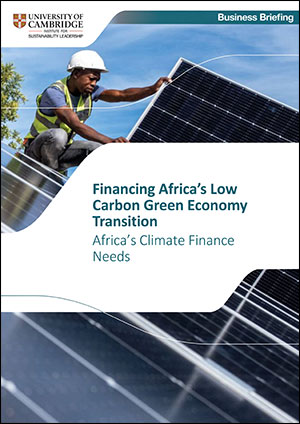30 January 2024 - A policy briefing by CISL examines how there is a $1.8 trillion gap to fund the transition to low carbon economies in Africa.
Download the policy briefing
This brief is intended to provide a basis for engagement on the key question for African climate finance: how much money do African states need to meet the transition commitments required by climate science?
Through a combination of meta-study of existing policy and academic research on the matter, as well as aggregating information from primary sources (NDC submissions, national policies, and national-level climate initiatives such as energy transitions) we find:
- African states will need to spend in the order of US$2.5 trillion by 2030 to meet their climate commitments.
- Emission reduction makes up close to 80% of spending, with plans for adaptation to climate change costed at US$418 billion. Of this total spending, unconditional pledges by African states – that is, the resources they intend to mobilise themselves – make up US$680 billion in spending, and roughly half of the 2GtCO2e in emissions cuts promised.
- The largest emitters and economies account for the bulk of financing needs: South Africa, Egypt and Nigeria alone comprise over half of the total needs.
- Delivering the more ambitious mitigation and adaptation projects will require a substantial mobilisation of both domestic and international funding.
- As it stands, the best available information shows total African climate finance flows at roughly US$30 billion per year in 2019/20 – insufficient to meet even the unconditional commitments.
- This is likely due to a combination of insufficient demand for climate projects (which speaks to the necessity of preparing an investable pipeline of projects at country level) and insufficient supply of finance, or at the least finance on the right terms.
- Many African states are under substantial fiscal strain, and cannot take on new market-rate, foreign denominated debt.
- While African states will have to increase domestic resource mobilisation for climate spending, the international funding community needs to provide far more finance, and on far more concessional terms, than they are at present.
- The most recent round of NDCs presents a mitigation strategy that is highly dependent on land use change & forestry. LULUCF projects represent close to 1GtCO2e (half) of total mitigation commitments.
- From a cost perspective, this is logical – LULUCF projects are by far the cheapest way to reduce emissions in Africa and deliver the greatest gains. However, they do not have many developmental gains, and are unlikely to be financed through private money.
- By contrast, energy sector mitigation through renewables, the second biggest source of mitigation (271MtCO2e), is both cheap (relative to other forms of new energy) and attractive to the private sector – but necessitates sufficient technological capacity to manage the grid and install generation.
- Energy efficiency in agriculture and better waste management form the bulk of other costed projects.
Citing this report
University of Cambridge Institute for Sustainability Leadership (CISL). (2024). Financing Africa’s Low Carbon Green Economy Transition. Cambridge, UK: University of Cambridge Institute for Sustainability Leadership.




